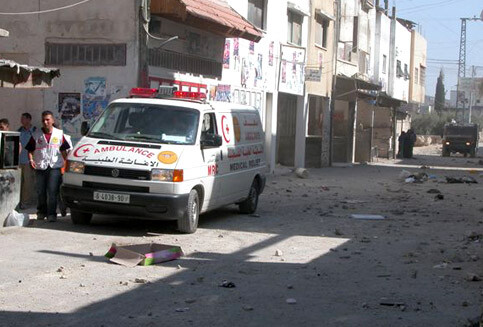UN Office for the Coordination of Humanitarian Affairs 6 April 2005

Throughout 2004, violence continued, particularly in the Gaza Strip, and the lives of thousands of Palestinians and Israelis alike were dramatically affected. (Markus Cuel)
Around half of the Palestinian population was living below the official poverty line last year, more than double the number in 2000, unemployment increased, and there is no hope for improvement unless guarded optimism on the political front is translated into economic activity, according to the latest United Nations review.
REVIEW OF THE HUMANITARIAN SITUATION IN THE OCCUPIED PALESTINIAN TERRITORY FOR 2004
This report summarises the main humanitarian trends in the occupied Palestinian territory (oPt) in 2004. It is an updated version of the report submitted in November 2004 by United Nations organisations working in the oPt to the Ad Hoc Liaison Committee, a committee of key international donors. Based primarily on a compilation of UN agency findings and OCHA field work, this report reviews the humanitarian needs in 2004 and the international humanitarian response. It also provides a brief overview of some causes of the humanitarian crisis and the role of humanitarian assistance in the oPt.
Humanitarian Trends in 2004 in the OPT
In 2004, the international humanitarian community remained actively involved in the oPt, focusing on four areas of humanitarian concern: impoverishment and a growing dependence on aid, further fragmentation of communities and services, assistance to areas of acute needs - the Gaza Strip, Nablus and south Hebron, and a need to ensure protection of civilians. In November 2004, 11 United Nations agencies together with six non-governmental organisations (NGOs) launched a “Consolidated Appeal” requesting US $302 million for humanitarian assistance for 2005 to focus on these four areas.
Throughout 2004, violence continued, particularly in the Gaza Strip, and the lives of thousands of Palestinians and Israelis alike were dramatically affected. In 2004, 118 Israelis and 881 Palestinians were killed including eight Israeli and 160 Palestinian children; a total of 602 Israelis and 4,009 Palestinians were injured. In 2004, 1,443 Palestinian buildings were demolished in the Gaza Strip resulting in the dispossession of 13,510 Palestinians.
There was no significant easing of the underlying causes of the crisis during 2004. Closure - the system of checkpoints and roadblocks established by Israel in an effort to safeguard its citizens - remained in place with only dozens of roadblocks out of hundreds being removed. Construction of the Barrier continued resulting in further humanitarian hardships.
The humanitarian situation in 2004 remained vulnerable. Around half of the Palestinian population was living below the official poverty line of US $2.10 per day (compared to just 22% in 2000). Furthermore, 16% of Palestinians (approximately 560,000 people) were in deep poverty. Unemployment increased as well. Palestinians continued to face problems reaching their places of work, schools and hospitals, and standards of health and education continued to deteriorate. In some parts of the territory, Palestinians’ needs for additional humanitarian assistance rose sharply as a consequence. The advisory opinion of the International Court of Justice (ICJ) in July 2004, brought a renewed focus to the role of international humanitarian law in the oPt.
The decision, along with the subsequent General Assembly resolution ES-10/15, called for an immediate halt to construction of the Barrier, and dismantlement of the parts that had already been built. Israeli High Court of Justice decisions throughout 2004 and the positions taken by the Israeli Attorney General Menachem Mazuz following the ICJ ruling, led to the re-examination of many sections of the Barrier route, and in some cases, delayed and called for revisions of the route.
There was limited optimism about the economic situation, as indicators for 2003 showed that Palestinian employment had increased and modest per capita GDP growth occurred. However, this economic stabilization remained short lived and appeared to be the result of freeing of tax revenues withheld by Israel in previous years, and the gradual adaptation of the Palestinian economy to the situation created by closure. Neither offered much potential for sustained recovery.
As the year ended, international actors focused on the opportunities presented by the Israeli plan to “disengage” from the Gaza Strip and from four West Bank settlements. A guarded optimism was evident in early 2005, a result of a successful Palestinian election process and the smooth transition to a new president of the Palestinian Authority (PA) President Mahmoud Abbas who replaced the late PA President, Yasser Arafat.
The PA was making detailed plans for transition from crisis to recovery. This transition is crucial: Palestinians depend heavily on external assistance, and the PA and donors must consider how to ensure that humanitarian assistance does not become a structural feature of the Palestinian economy. Yet transition will not be possible unless conflict eases and access both within the West Bank and the Gaza Strip and to external areas improves, and conditions are created for normal economic activity. Even if rapid progress is made on the political front unless this is translated into improvements in access, emergency humanitarian assistance continues to remain necessary at current levels to prevent a further decline in the humanitarian situation.
This report analyzes the UN’s four focus areas of concern and provides an overview of some of the humanitarian responses developed to address them. It also discusses some causes of the crisis, the role of humanitarian assistance and the opportunities for transition in 2005.
To download the full report (PDF) click here.
Related Links